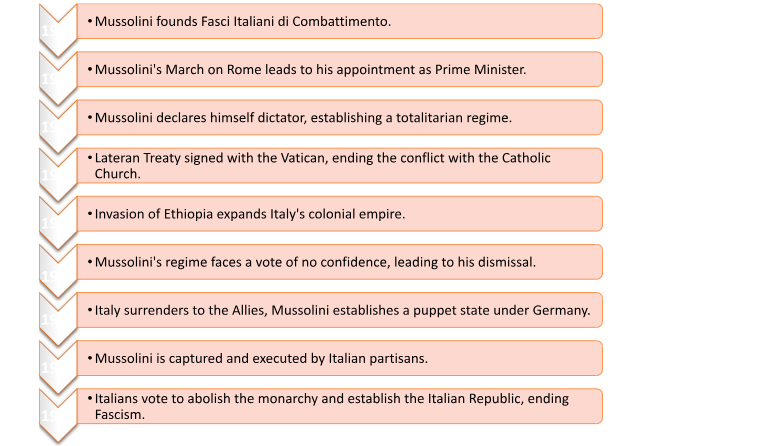Italian Fascism
Published on 23 Oct 2025
Italian Fascism was a far-right political ideology led by Benito Mussolini, rising in the early 20th century. Characterized by authoritarianism, nationalism, corporatism, and suppression of political opposition, it gained power in Italy in the 1920s and ultimately collapsed with the fall of Mussolini's regime during World War II in 1943.
Timeline of Italian Fascism

Factors for the Rise of Mussolini
Political Factors
Treaty of St. Germain Grievance: Italian ultra-nationalists were dissatisfied with the Treaty of St. Germain, perceiving it as a betrayal of Italy's territorial claims after World War I.
Opportunistic Promises: Mussolini made political promises to various social groups in Italy to gain their support.
Suppression of Communism: Mussolini portrayed himself as a strong leader opposing the communist threat.
The March on Rome: Mussolini marched to Rome with 50,000 'Black Shirt' volunteers, creating an impression of a mass movement demanding change leading to his appointment as Prime Minister by King Victor Emmanuel III.
Cult of Personality: Mussolini projected himself as a charismatic leader capable of solving Italy's problems.
Example: The consolidation of power through centralization and appointment of loyal officers ensured Mussolini's control over the state apparatus.
Social Factors
Weakness of Opposition: The liberal and communist parties failed to form a united front against Mussolini.
Fear of Communism: The rise of communism in Italy alarmed conservative and anti-communist segments of society.
Economic Factors
World Economic Depression: The global economic downturn of 1929-1930 impacted Italy's economy, leading to widespread unemployment and economic hardships.
Example: He introduced the 'Corporate State System' to address the economic crisis and provide a sense of stability.
Impact of Italian Fascism
Global Fascist Influence: Mussolini's rise to power and the establishment of Italian Fascism inspired similar right-wing movements worldwide.
Example: The rise of Hitler's Nazi Party in Germany drew inspiration from Mussolini's success in Italy and sought to emulate his authoritarian tactics and nationalist rhetoric.
Axis Alliance: Mussolini's Italy formed the Axis alliance with Nazi Germany in 1936, creating a formidable partnership that threatened peace and stability in Europe.
Example: The Axis Powers' collaboration during World War II led to military campaigns and territorial expansion in various parts of Europe and Africa.
Imperial Expansion: Mussolini's invasion of Ethiopia in 1935 demonstrated Italy's imperial ambitions and desire to expand its colonial territories.
Example: The Second Italo-Ethiopian War.
Impact on Global Politics: The rise of fascism and the Axis Powers in the 1930s and 1940s fundamentally reshaped the geopolitical landscape.
Example: The aggressions of the Axis Powers, including Italy's invasion of Albania and Greece, triggered conflicts and alliances that led to World War II.
Lateran Treaty with the Vatican: Mussolini's Lateran Treaty with the Vatican in 1929 recognized the sovereignty of Vatican City and ended long-standing disputes.
Human Rights Violations: Mussolini's regime implemented racial laws discriminating against Jews and persecuted political opponents.
Example: The enactment of anti-Semitic laws in 1938 led to the persecution and deportation of Italian Jews, contributing to human rights abuses during the fascist era.